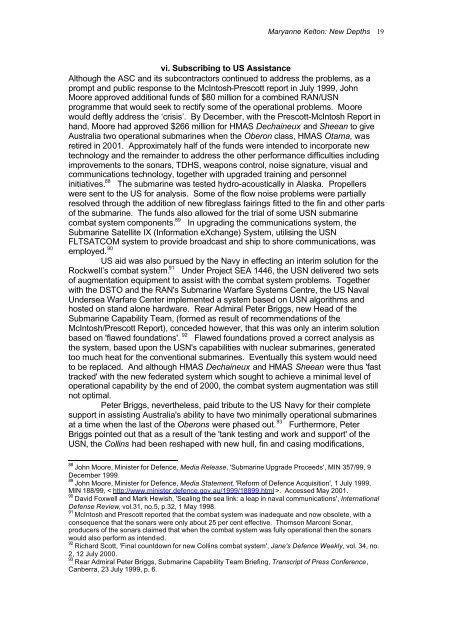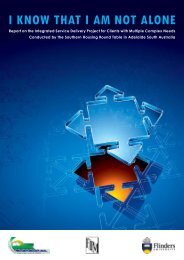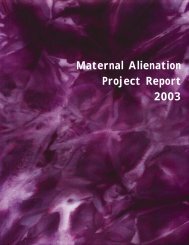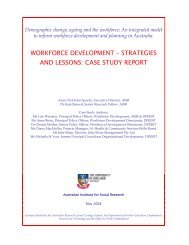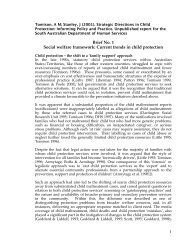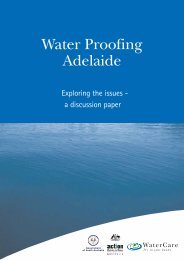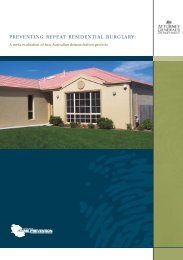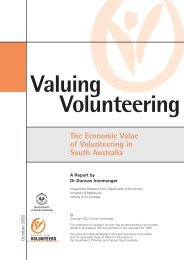New Depths in Australia-US Relations: The Collins Class ...
New Depths in Australia-US Relations: The Collins Class ...
New Depths in Australia-US Relations: The Collins Class ...
Create successful ePaper yourself
Turn your PDF publications into a flip-book with our unique Google optimized e-Paper software.
Maryanne Kelton: <strong>New</strong> <strong>Depths</strong> 19vi. Subscrib<strong>in</strong>g to <strong>US</strong> AssistanceAlthough the ASC and its subcontractors cont<strong>in</strong>ued to address the problems, as aprompt and public response to the McIntosh-Prescott report <strong>in</strong> July 1999, JohnMoore approved additional funds of $80 million for a comb<strong>in</strong>ed RAN/<strong>US</strong>Nprogramme that would seek to rectify some of the operational problems. Moorewould deftly address the ‘crisis’. By December, with the Prescott-McIntosh Report <strong>in</strong>hand, Moore had approved $266 million for HMAS Decha<strong>in</strong>eux and Sheean to give<strong>Australia</strong> two operational submar<strong>in</strong>es when the Oberon class, HMAS Otama, wasretired <strong>in</strong> 2001. Approximately half of the funds were <strong>in</strong>tended to <strong>in</strong>corporate newtechnology and the rema<strong>in</strong>der to address the other performance difficulties <strong>in</strong>clud<strong>in</strong>gimprovements to the sonars, TDHS, weapons control, noise signature, visual andcommunications technology, together with upgraded tra<strong>in</strong><strong>in</strong>g and personnel<strong>in</strong>itiatives. 88 <strong>The</strong> submar<strong>in</strong>e was tested hydro-acoustically <strong>in</strong> Alaska. Propellerswere sent to the <strong>US</strong> for analysis. Some of the flow noise problems were partiallyresolved through the addition of new fibreglass fair<strong>in</strong>gs fitted to the f<strong>in</strong> and other partsof the submar<strong>in</strong>e. <strong>The</strong> funds also allowed for the trial of some <strong>US</strong>N submar<strong>in</strong>ecombat system components. 89 In upgrad<strong>in</strong>g the communications system, theSubmar<strong>in</strong>e Satellite IX (Information eXchange) System, utilis<strong>in</strong>g the <strong>US</strong>NFLTSATCOM system to provide broadcast and ship to shore communications, wasemployed. 90<strong>US</strong> aid was also pursued by the Navy <strong>in</strong> effect<strong>in</strong>g an <strong>in</strong>terim solution for theRockwell’s combat system. 91 Under Project SEA 1446, the <strong>US</strong>N delivered two setsof augmentation equipment to assist with the combat system problems. Togetherwith the DSTO and the RAN's Submar<strong>in</strong>e Warfare Systems Centre, the <strong>US</strong> NavalUndersea Warfare Center implemented a system based on <strong>US</strong>N algorithms andhosted on stand alone hardware. Rear Admiral Peter Briggs, new Head of theSubmar<strong>in</strong>e Capability Team, (formed as result of recommendations of theMcIntosh/Prescott Report), conceded however, that this was only an <strong>in</strong>terim solutionbased on 'flawed foundations'. 92 Flawed foundations proved a correct analysis asthe system, based upon the <strong>US</strong>N's capabilities with nuclear submar<strong>in</strong>es, generatedtoo much heat for the conventional submar<strong>in</strong>es. Eventually this system would needto be replaced. And although HMAS Decha<strong>in</strong>eux and HMAS Sheean were thus 'fasttracked' with the new federated system which sought to achieve a m<strong>in</strong>imal level ofoperational capability by the end of 2000, the combat system augmentation was stillnot optimal.Peter Briggs, nevertheless, paid tribute to the <strong>US</strong> Navy for their completesupport <strong>in</strong> assist<strong>in</strong>g <strong>Australia</strong>'s ability to have two m<strong>in</strong>imally operational submar<strong>in</strong>esat a time when the last of the Oberons were phased out. 93 Furthermore, PeterBriggs po<strong>in</strong>ted out that as a result of the 'tank test<strong>in</strong>g and work and support' of the<strong>US</strong>N, the Coll<strong>in</strong>s had been reshaped with new hull, f<strong>in</strong> and cas<strong>in</strong>g modifications,88 John Moore, M<strong>in</strong>ister for Defence, Media Release, 'Submar<strong>in</strong>e Upgrade Proceeds', MIN 357/99, 9December 1999.89 John Moore, M<strong>in</strong>ister for Defence, Media Statement, 'Reform of Defence Acquisition', 1 July 1999,MIN 188/99, < http://www.m<strong>in</strong>ister.defence.gov.au/1999/18899.html >. Accessed May 2001.90 David Foxwell and Mark Hewish, 'Seal<strong>in</strong>g the sea l<strong>in</strong>k: a leap <strong>in</strong> naval communications', InternationalDefense Review, vol.31, no.5, p.32, 1 May 1998.91 McIntosh and Prescott reported that the combat system was <strong>in</strong>adequate and now obsolete, with aconsequence that the sonars were only about 25 per cent effective. Thomson Marconi Sonar,producers of the sonars claimed that when the combat system was fully operational then the sonarswould also perform as <strong>in</strong>tended.92 Richard Scott, 'F<strong>in</strong>al countdown for new Coll<strong>in</strong>s combat system', Jane's Defence Weekly, vol. 34, no.2, 12 July 2000.93 Rear Admiral Peter Briggs, Submar<strong>in</strong>e Capability Team Brief<strong>in</strong>g, Transcript of Press Conference,Canberra, 23 July 1999, p. 6.


